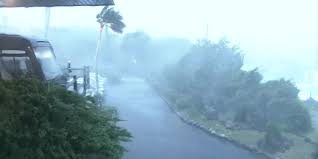The Izu Islands, located south of Tokyo, are facing widespread damage after being struck by two powerful typhoons in rapid succession — Typhoon Halong and Typhoon Nakri. The twin storms brought torrential rains, destructive winds, and towering waves that battered the region over the past week.
Typhoon Nakri Brings Severe Winds and Destruction
According to Japan’s Meteorological Agency (JMA), Typhoon Nakri, the more recent of the two, made its closest approach on Thursday with sustained winds reaching 95 miles per hour (around 150 kilometers per hour) and waves as high as 9 meters. The storm left a trail of destruction across parts of Shizuoka and Kanagawa Prefectures, where one fatality was reported off the coast of Kanagawa after a fishing vessel capsized amid rough seas.
Halong’s Aftermath Worsened Nakri’s Impact
Typhoon Halong, which struck just days earlier, had already saturated the soil and weakened infrastructure, increasing the risk of landslides and flooding when Nakri arrived. Emergency crews reported multiple landslides blocking roads, widespread power outages, and severe damage to ports and coastal defenses across the island chain.
More than 10,000 residents were temporarily evacuated from low-lying areas, while ferry services and flights to and from the Izu Islands were suspended due to hazardous conditions. Authorities have begun assessing the damage, warning that additional landslides remain possible as the ground stays heavily waterlogged.
Government Response and Climate Concerns
Prime Minister Fumio Kishida expressed condolences to the family of the deceased and urged local governments to “prioritize safety and restoration of essential services.”
Meteorologists warn that the back-to-back typhoons highlight a troubling pattern of increasingly frequent and intense storms linked to warming ocean temperatures — a growing concern for Japan, which faces some of the world’s most active typhoon seasons.
Recovery Underway as Conditions Improve
Recovery operations are now in motion across the affected areas as weather conditions gradually improve. However, the JMA has cautioned that additional heavy rainfall is expected in parts of central Honshu through the weekend, which could hinder repair efforts and increase the risk of further flooding.

